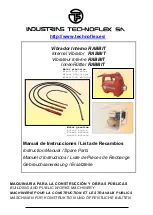
12
TRANSPORTING
• ALWAYS shut down engine before transport-
ing.
• Tighten fuel tank cap securely and close fuel
cock to prevent fuel from spilling.
• Drain fuel when transporting rammer over
long distances or bad roads.
• When placing the rammer inside a truck-bed
for transport, always tie-down the rammer.
EMERGENCIES
· ALWAYS know the location of the nearest fire
extinguisher and first aid kit.
· In emergencies always know the location of
the nearest phone or keep a phone on the
job site. Also know the phone numbers of the
nearest ambulance, doctor and fire depart-
ment. This information will be invaluable in
the case of an emergency.
FEATURES
The tamping rammer is a powerful compacting
tool capable of applying a tremendous force in
consecutive impacts to a soil surface. Its appli-
cations include soil compacting for road, em-
bankments and reservoirs as well as backfilling
for gas pipelines, water pipelines and cable
installation work.
Circular motion is converted to create impact
force. The tamping rammer develops a power-
ful compacting force at the foot of the ram-
mer. To maintain optimum performance, prop-
er operation and service are essential.
CONSTRUCTION
The tamping rammer is equipped with an air
cooled, four-cycle gasoline engine. Transmis-
sion of the power takes place by increasing the
engine speed to engage the centrifugal clutch.
KNOW YOUR TOOL
Before attempting to use this product, become
familiar with all of its operating features and
safety requirements.
1. Throttle Lever: Controls engine speed and
the tamping action of the rammer.
2. Engine Stop Switch: Controls the starting
and stopping of the engine. Switch must be in
the “ON” position when starting the engine.
3. Choke Lever: Used when starting the engine.
Normally used in cold weather conditions. In
cold weather turn the choke lever to the fully
closed position, in warm weather set choke
lever half way or completely open.
4. Fuel Shut-Off Valve: Supplies fuel from the
fuel tank to the engine. To begin fuel flow
move the fuel shut-off valve downward.
7. Pre-Cleaner: Pre-cleans (first stage) dirt and
other debris from entering the engine.
8. Foot: Laminated wood with tempered steel
plate for superior shock absorption.
9. Oil Level Sight Glass: Indicates the level of
oil in the oil bath reservoir.
10. Recoil Starting Handle: Used when start-
ing the engine. Pull starter handle sharply and
quickly, then return starter handle to starter
case before releasing.
11. Fuel Tank/Cap: Poly fuel tank to avoid rust
and corrosion, remove this cap to add gasoline.
12. Engine Air Cleaner: Prevents dirt (second
stage) and other debris from entering the en-
gine.
13. Bellows: Reservoir for oil bath.
14. Handle: To operate rammer, grip handle
assembly firmly on both sided.
15. Muffler: Used to reduce noise and emis-
sions.
16. Spark Plug: Provides spark to the ignition
system, replace with engine manufacturers
recommended type spark plug.
17. Nameplate: Displays information regarding
the rammer.
MOTOR
The engine must be checked for proper lubri-
cation and filled with fuel prior to operation.
Refer to the Engine User’s Manual for instruc-
tions.
BVC830-BVC940 manual.indd 12
23/09/16 4:13 p.m.























